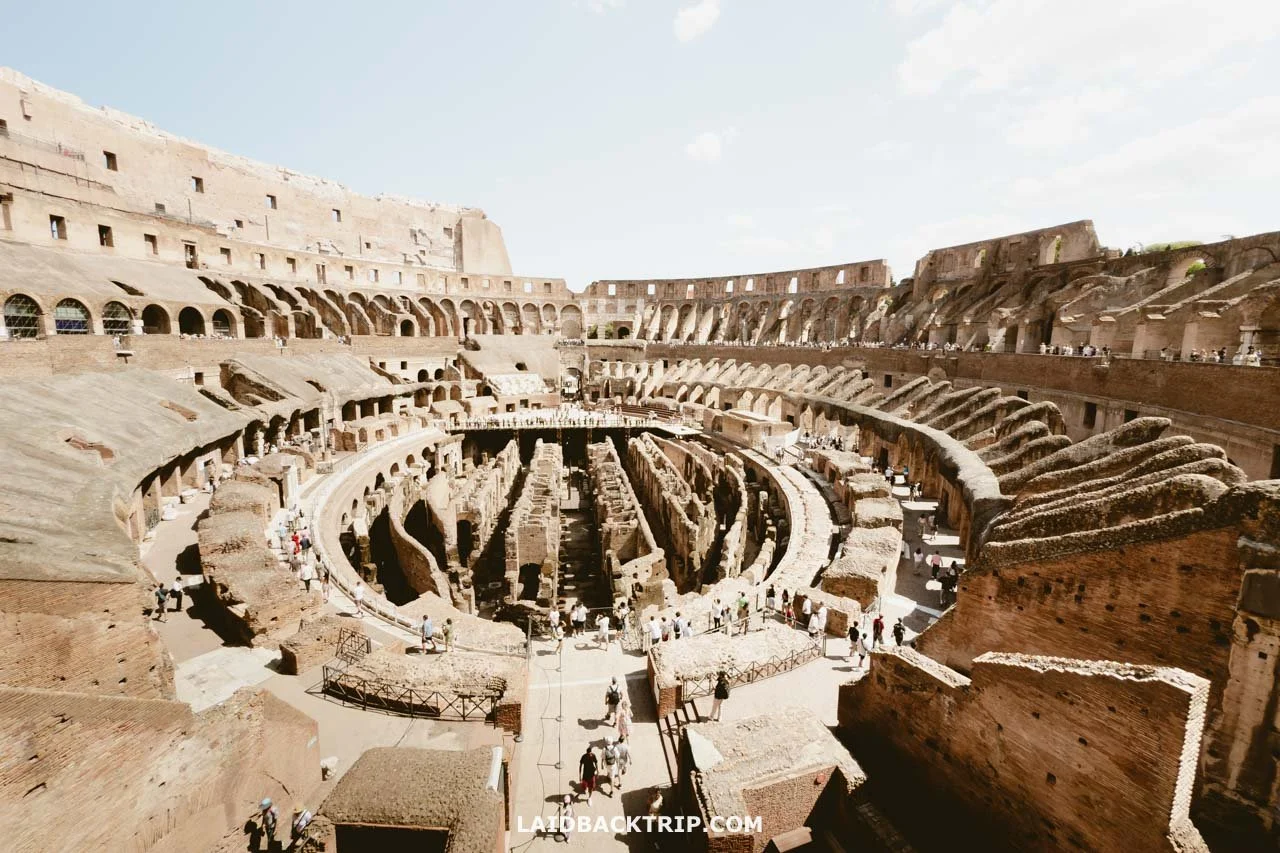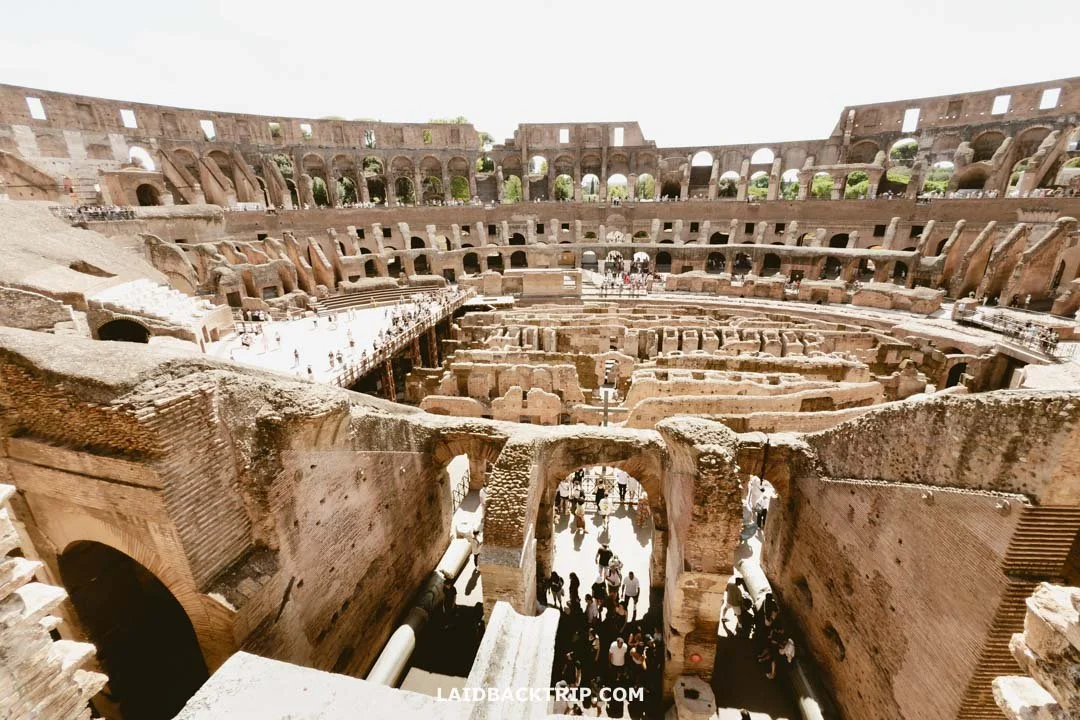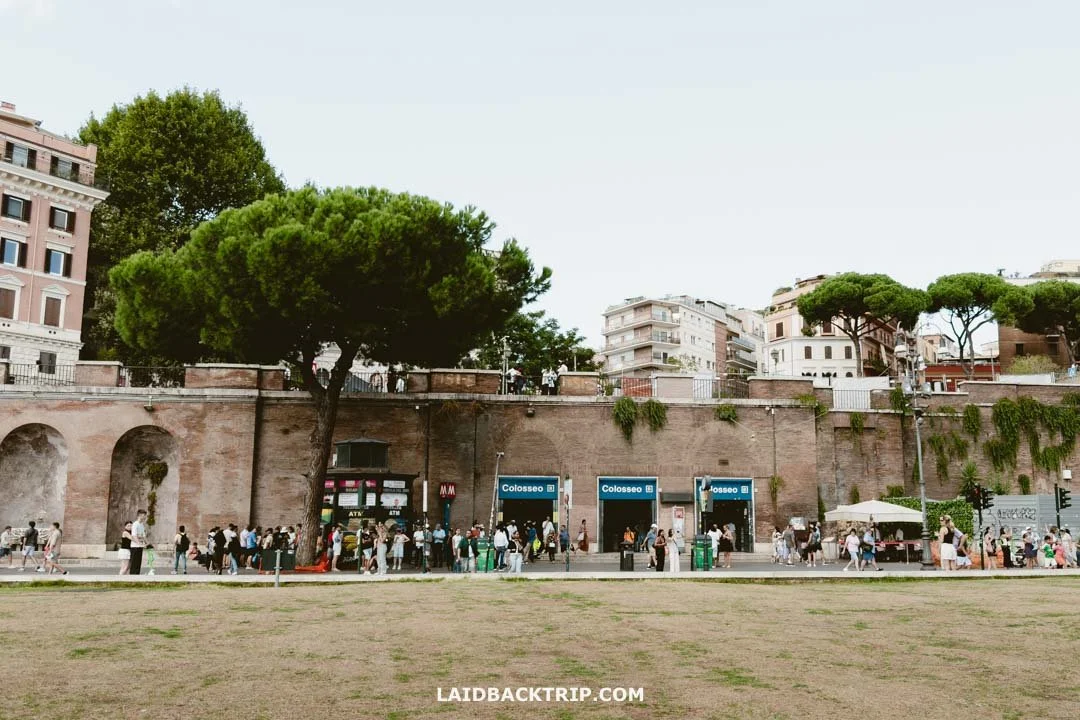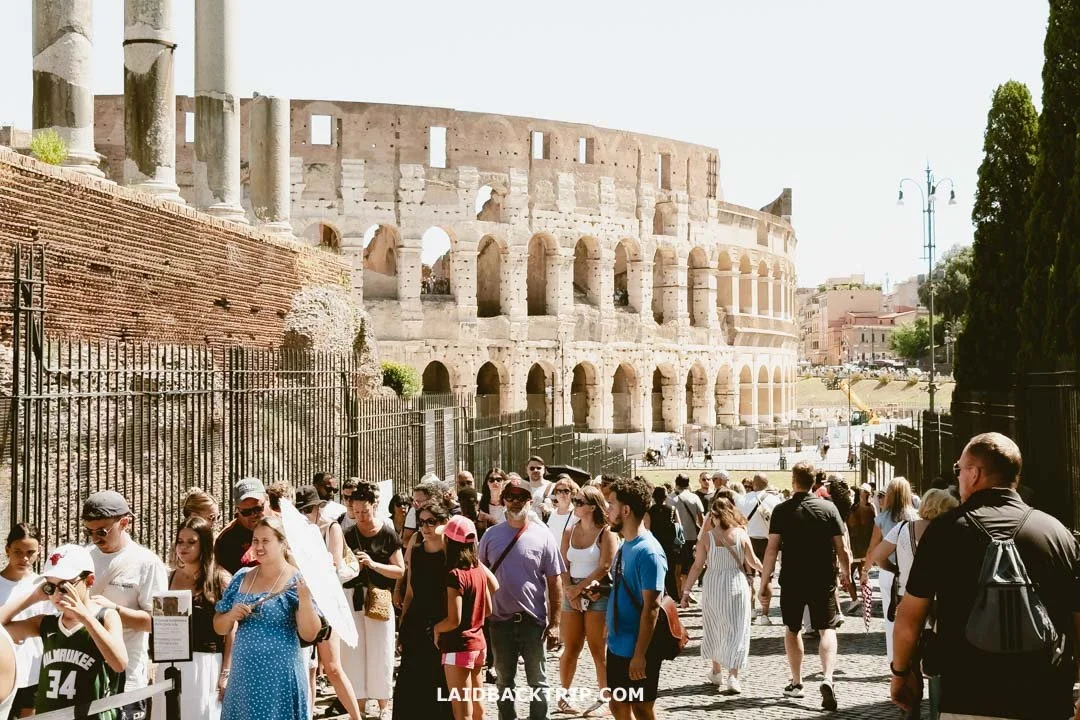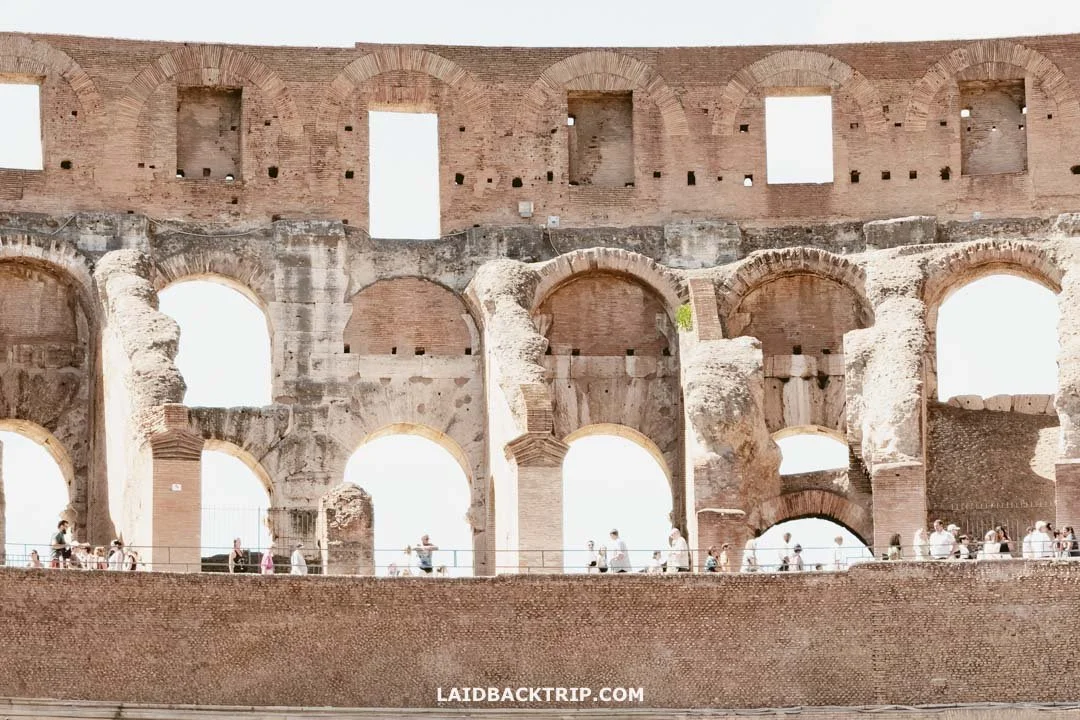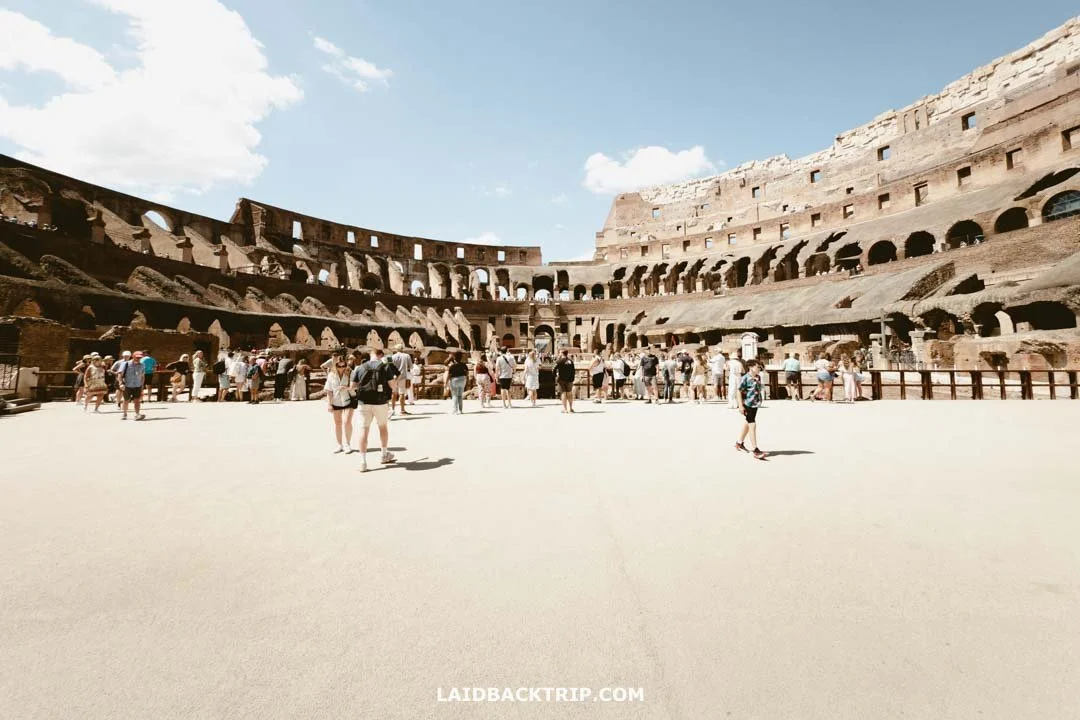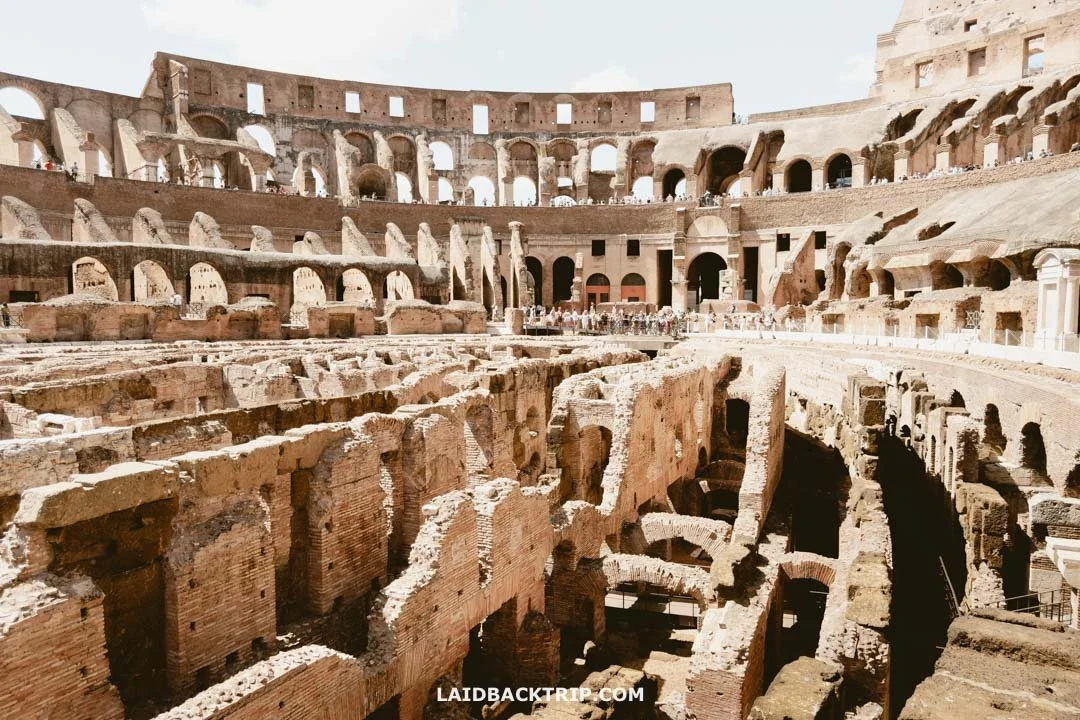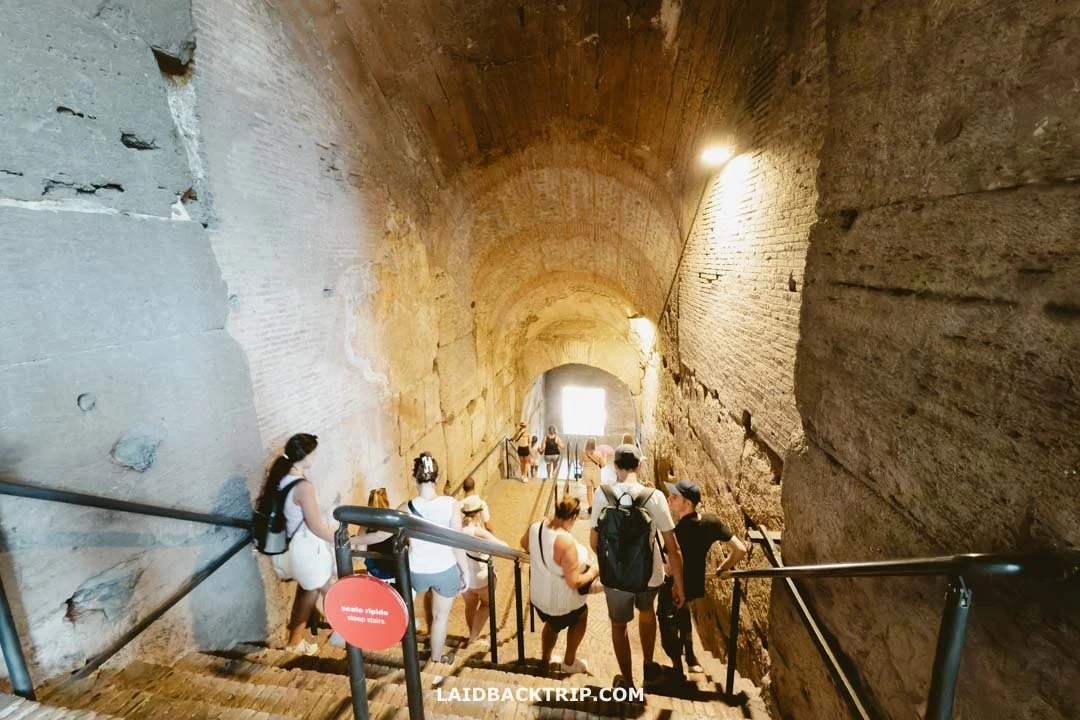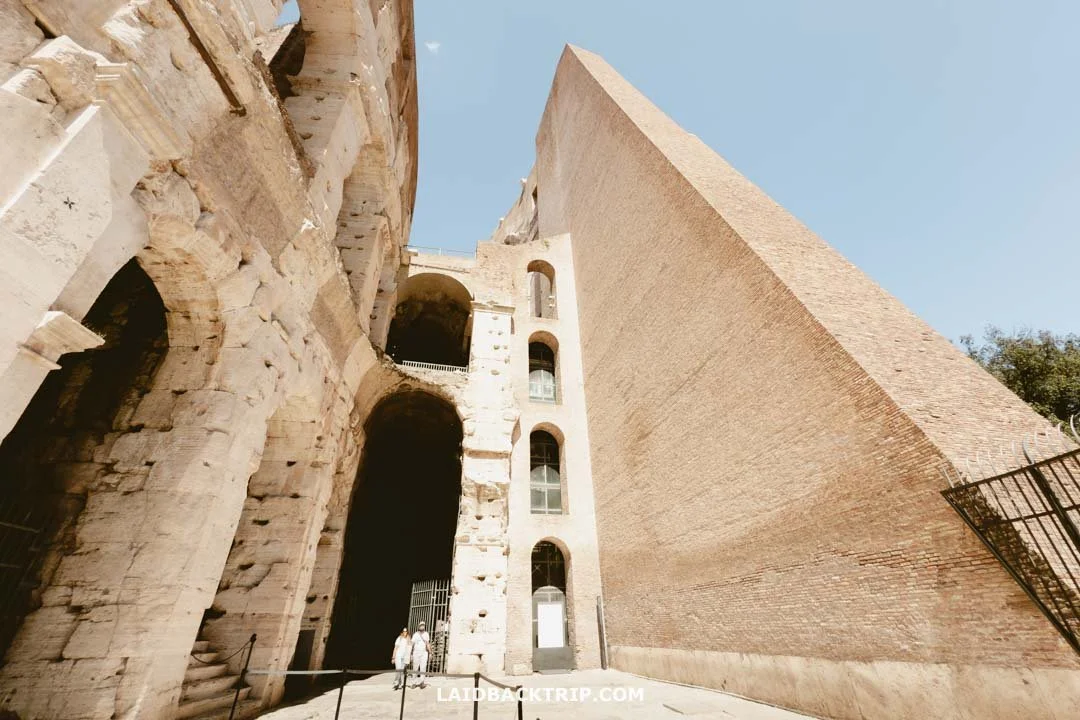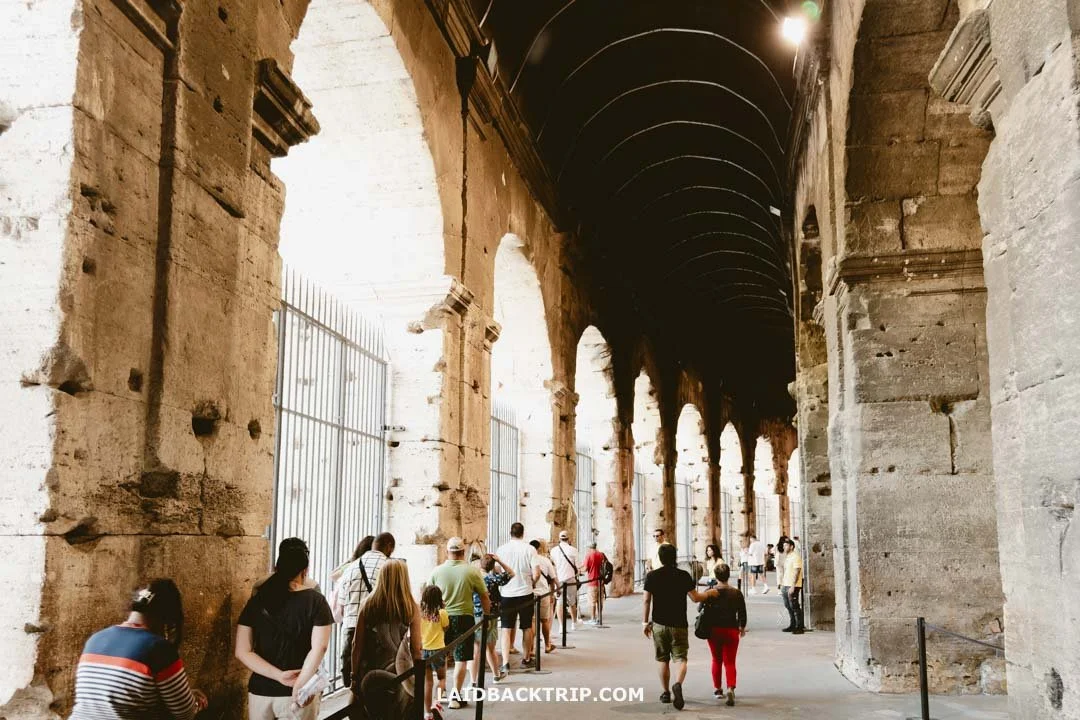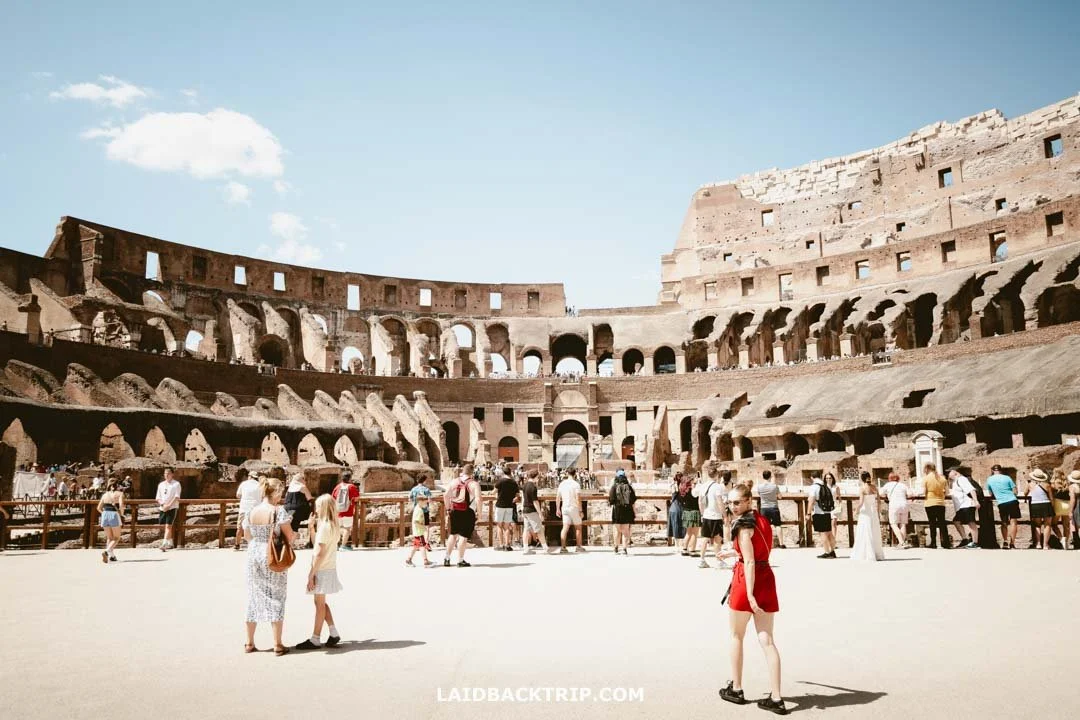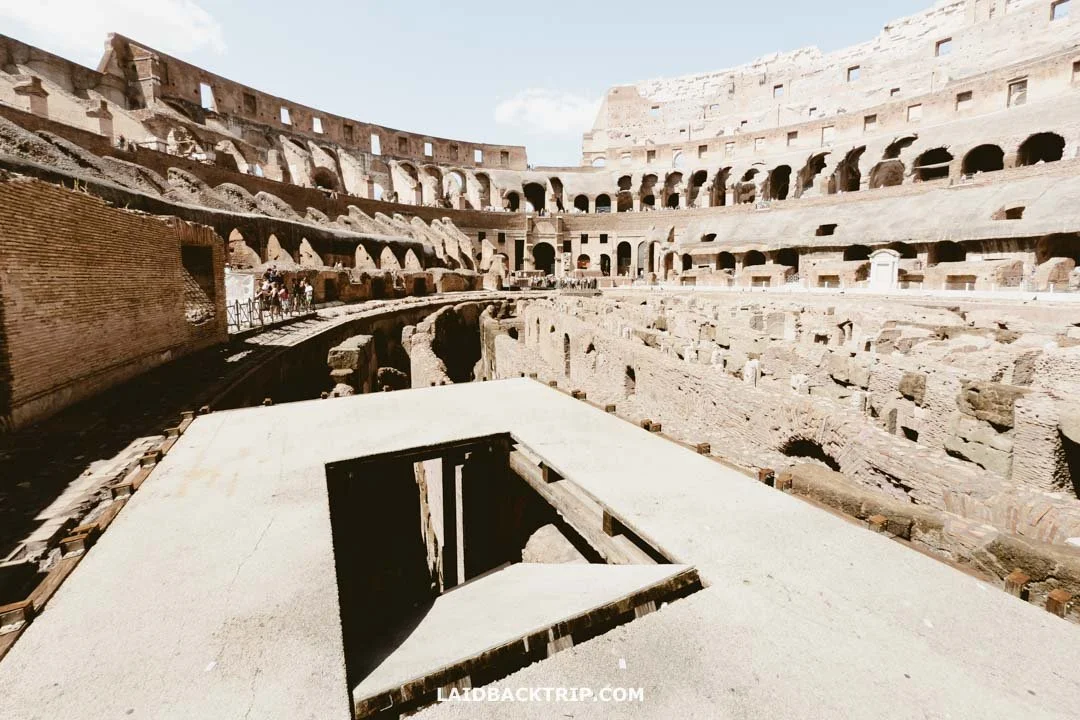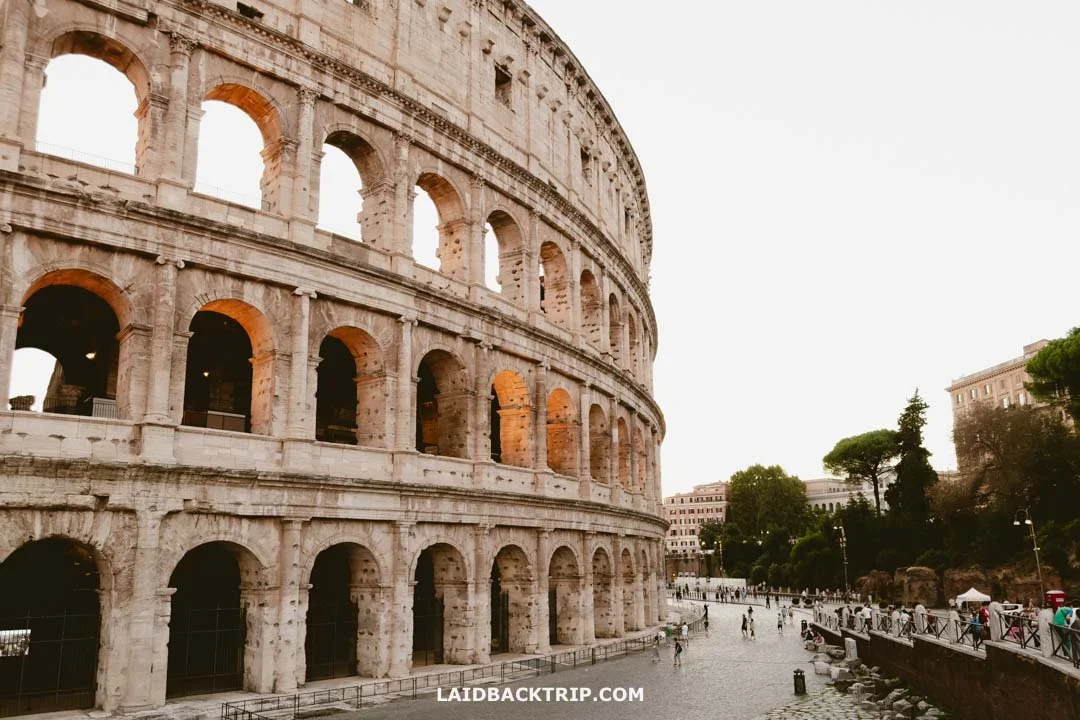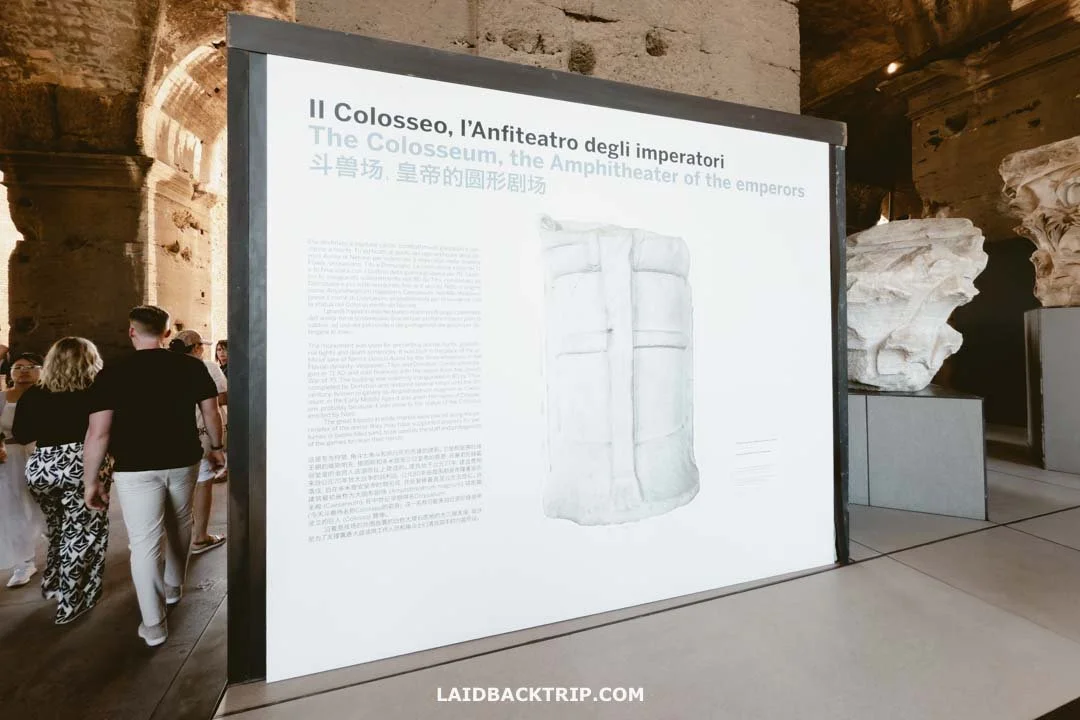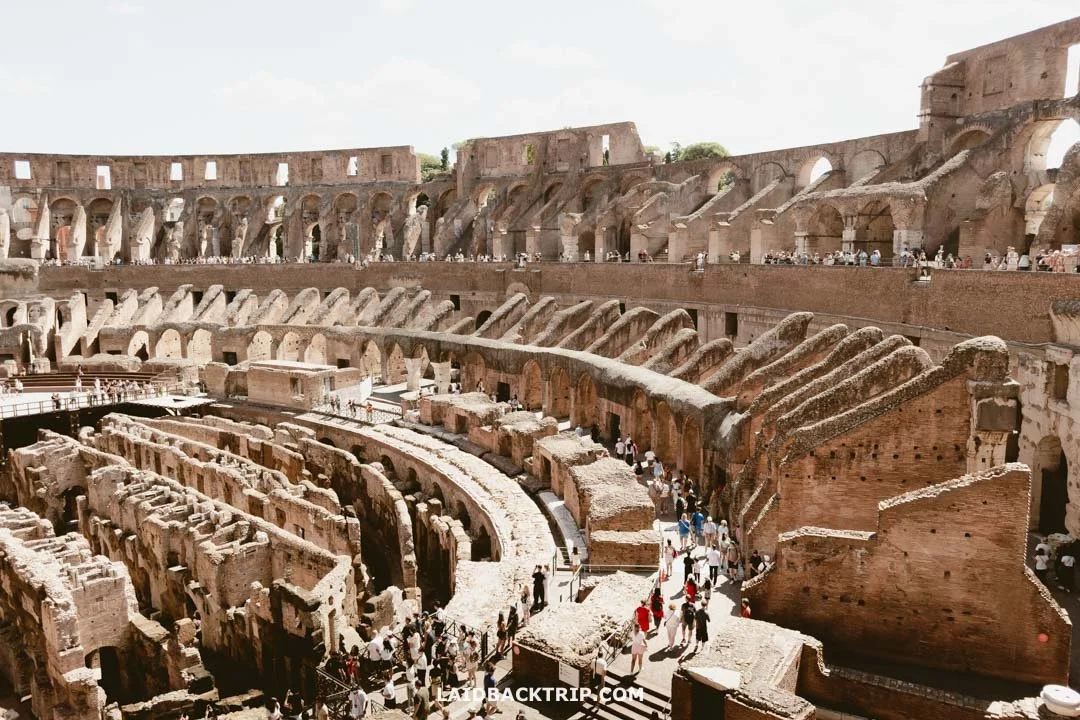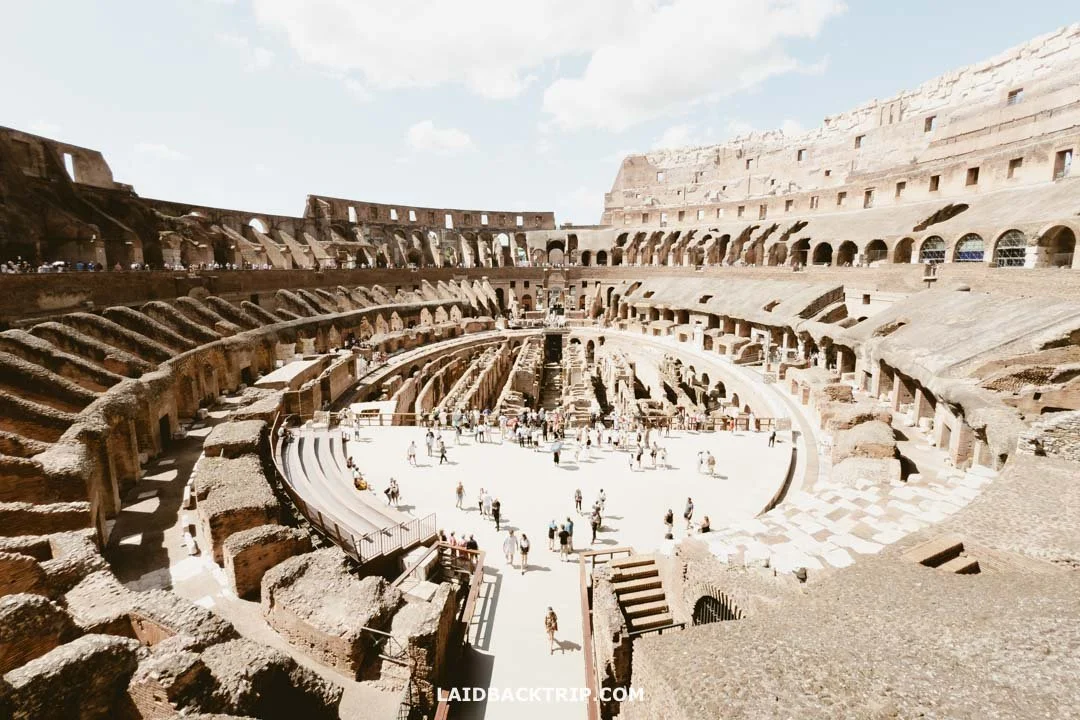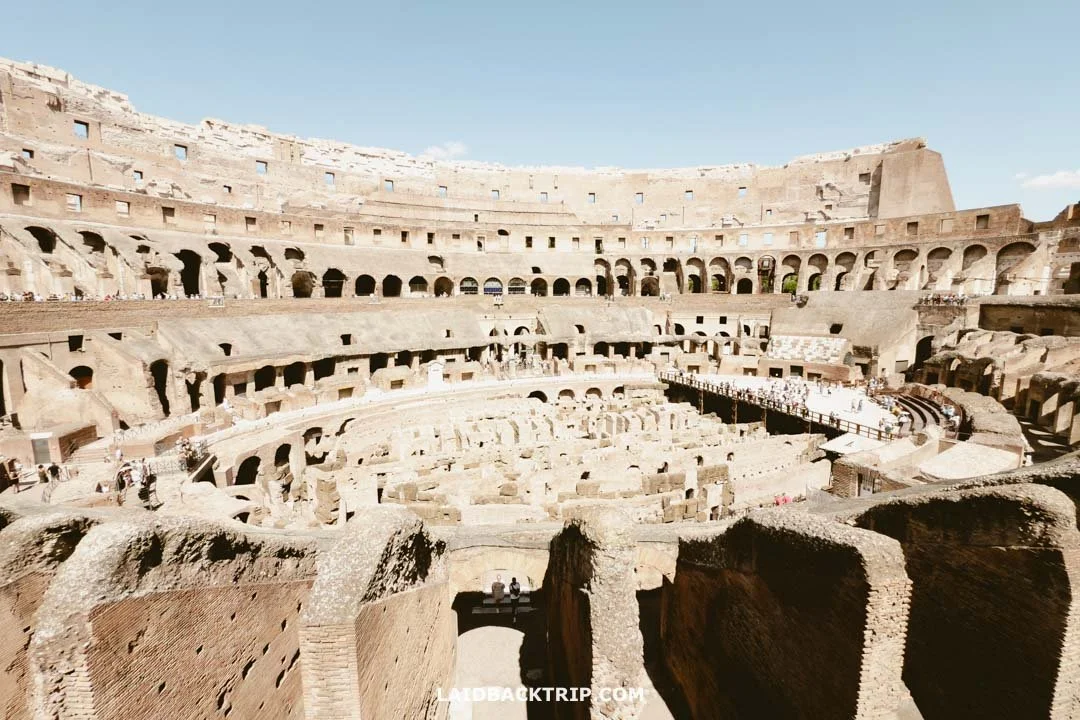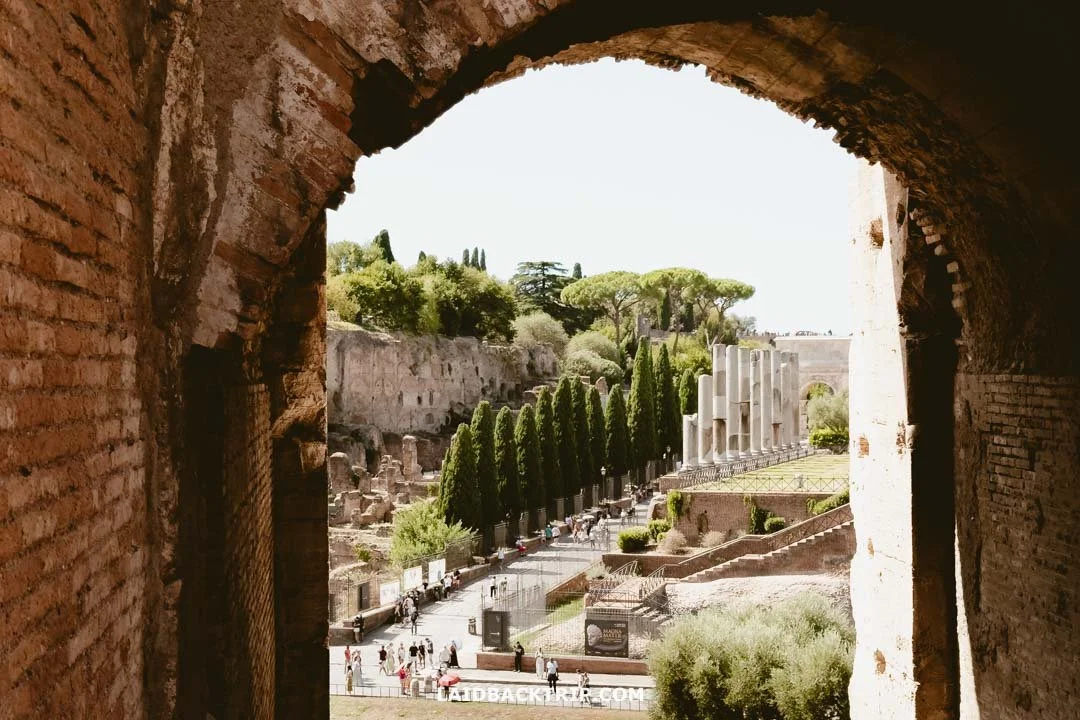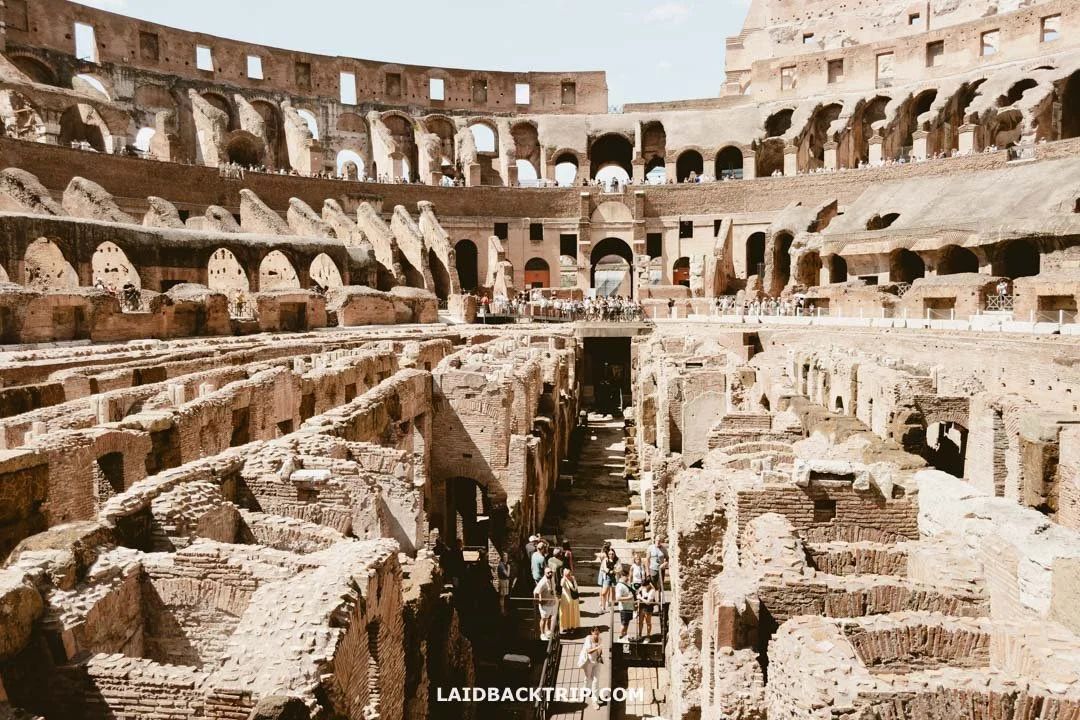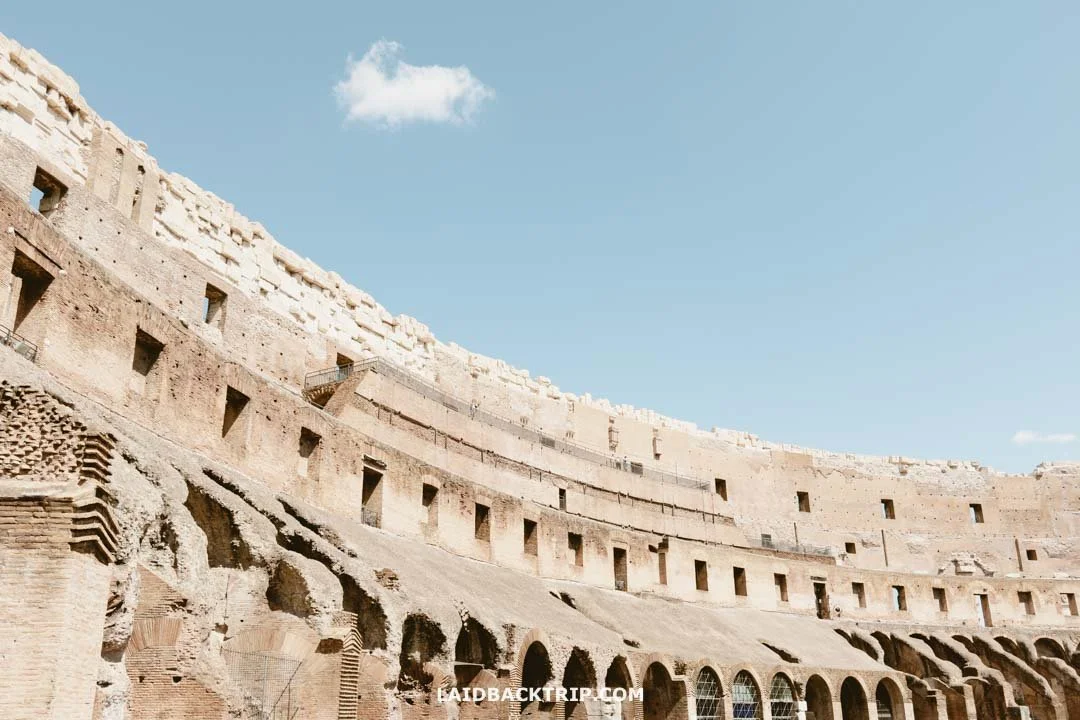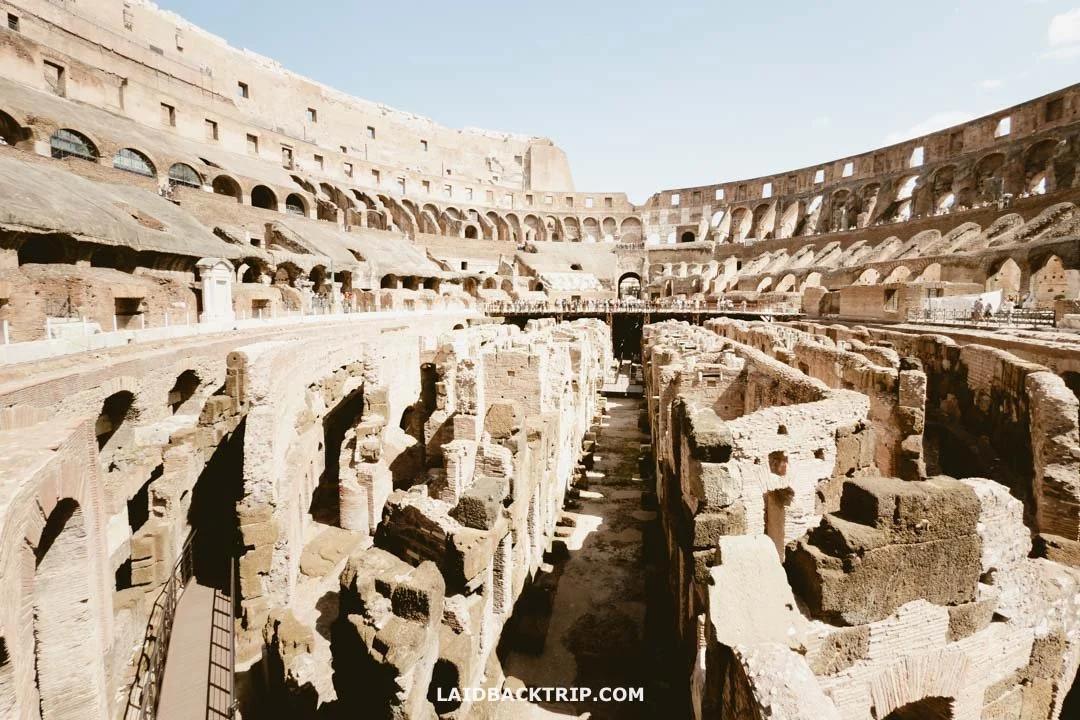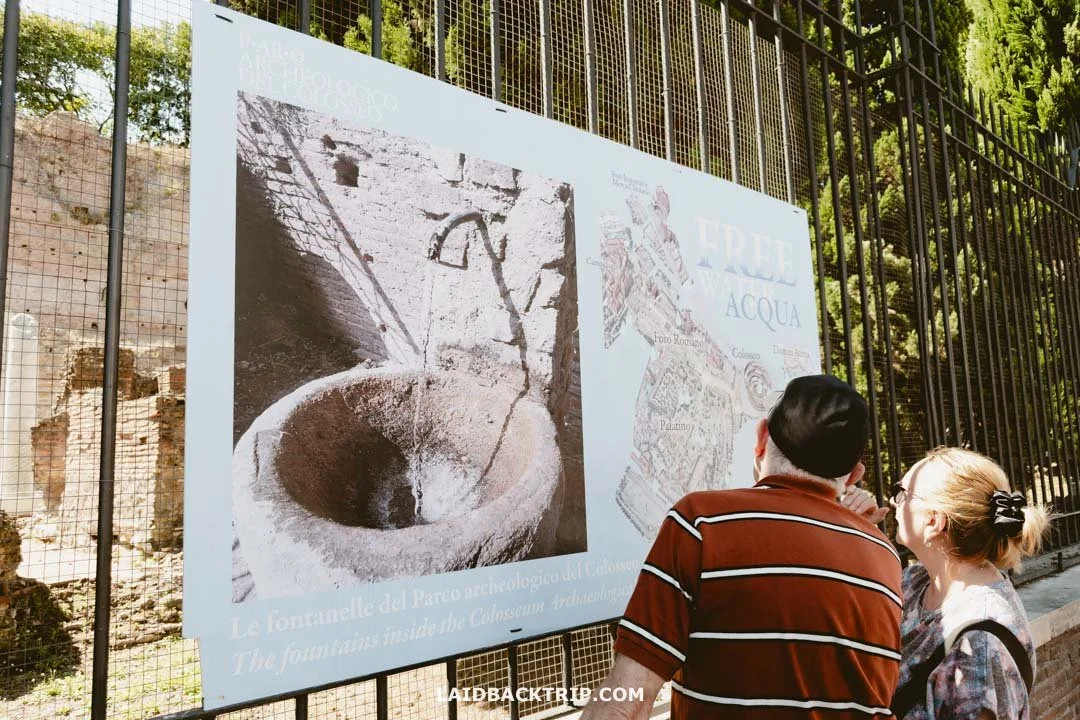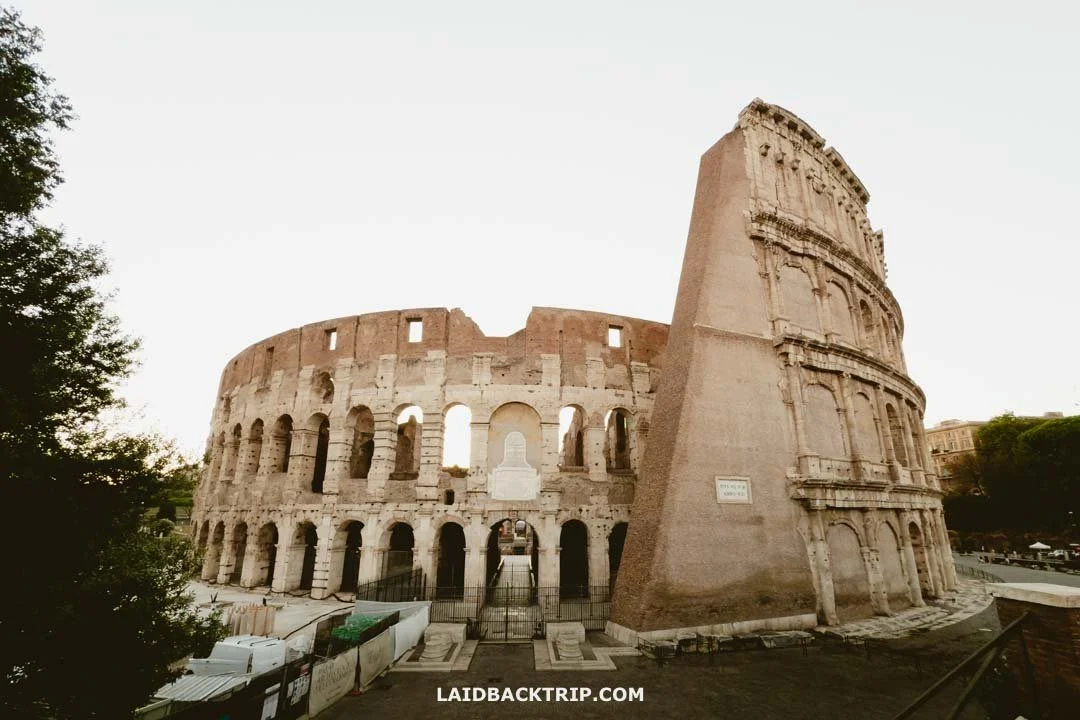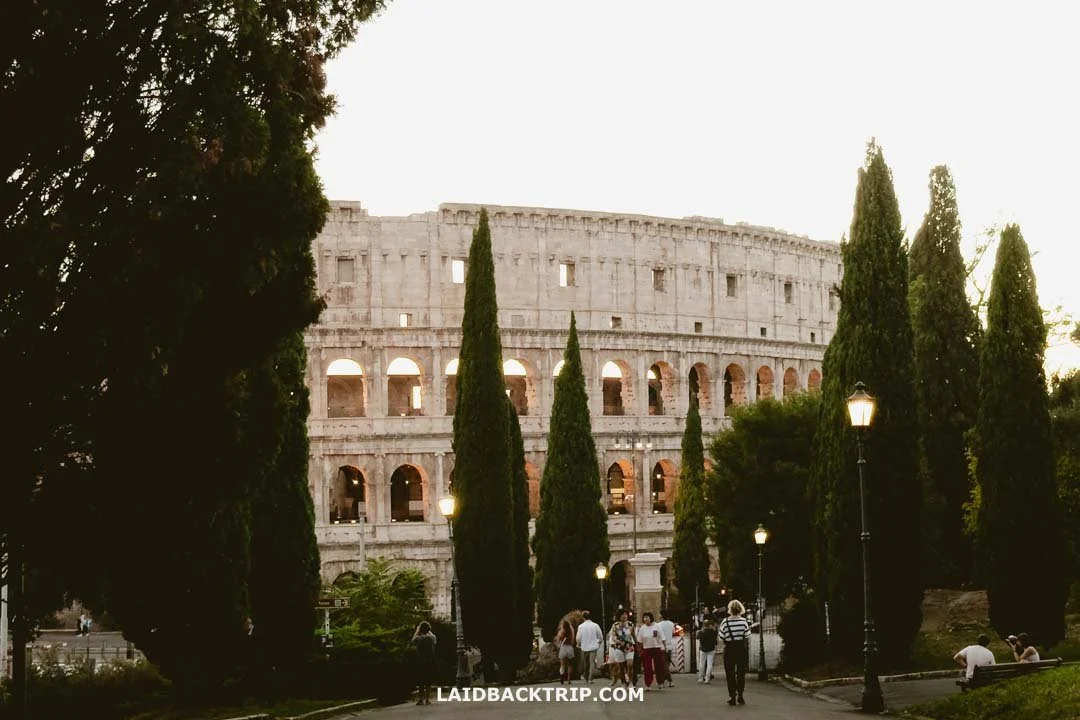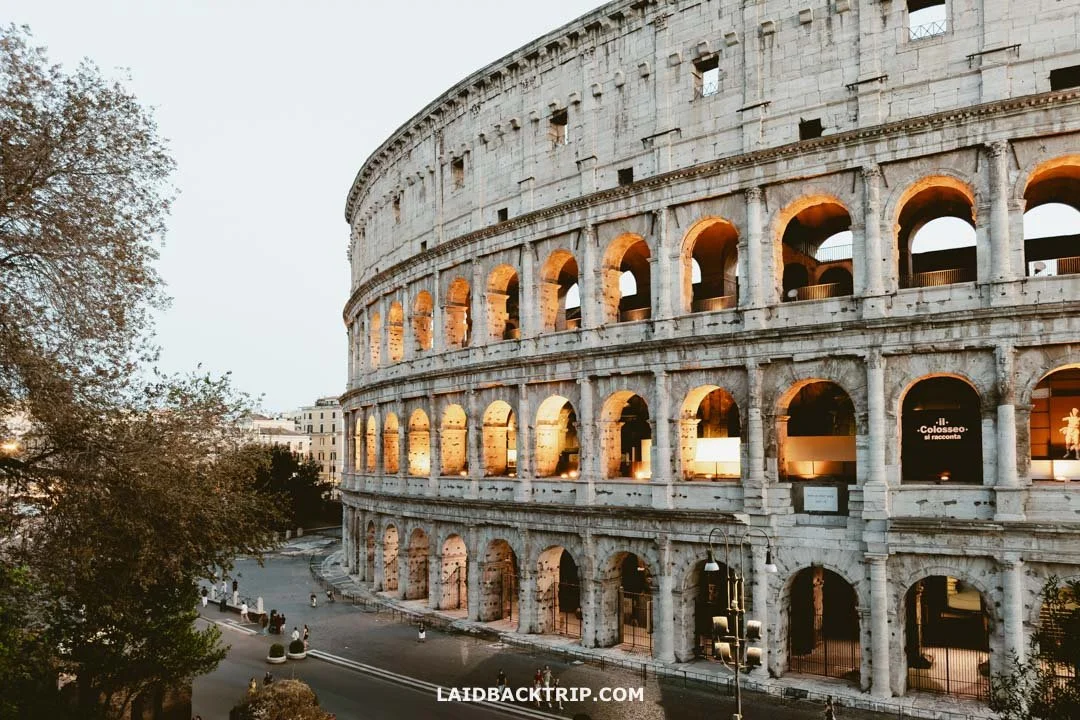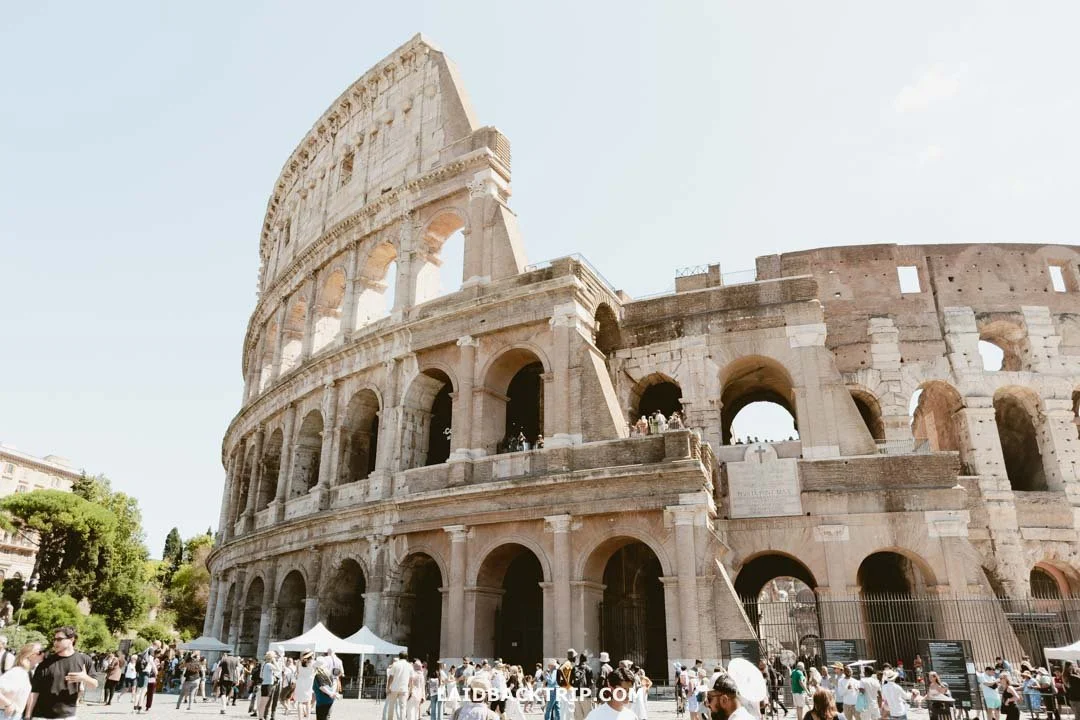How to Visit Colosseum (Without a Guide)
The Colosseum is easily Rome's most famous historic spot.
Join us visiting the Colosseum, that huge Roman arena for brutal gladiatorial contests and public spectacles.
After a whole morning wandering through the Roman Forum, we were eager to check out Rome's most famous attraction, the legendary Colosseum. It wasn't hard to find because both places sit side by side, so we just followed our noses and headed toward the massive structure we could already see ahead.
Lucie and I were super excited to see the well-preserved 2,000-year-old Roman ruins, so we planned to visit the inside the day after arriving in Rome. The experience was incredible, but it wasn't our only time there. During the next few days, we passed by often and felt amazed every single time. In this guide, though, we'll mainly focus on what it was like exploring the Colosseum's interior and share a few tips on viewing it from the outside.
The Colosseum is more than just a Roman ruin. It's quite easily one of the world's most famous landmarks. Built in the 1st century CE, this massive amphitheater could hold as many as 80,000 spectators. It's included in the UNESCO World Heritage Site list as part of the Historic Center of Rome, added back in 1980. In 2001, it earned another title as one of the New 7 Wonders of the World. And even though that ranking was a bit subjective, it just shows how remarkable this place was. And, honestly, still is today.
The Colosseum is easily one of the most iconic places in the world.
I actually visited the Colosseum about 25 years ago, and I have to admit that my memory of the visit itself is pretty fuzzy. I remember being blown away by the structure, but the overall experience felt a bit underwhelming. I think it was partly because I was too young to fully appreciate what I was seeing, and also because the guided tour (yeah, we joined one back then) wasn't that great since it was pretty short.
This time, though, I was ready to spend as much time as we needed inside the Colosseum. And while I was really interested to see what Lucie would think of the whole experience, I was even more curious about mine. So, let's see how our visit to the Colosseum went.
The Colosseum was essentially a giant stadium in ancient Rome.
How We Got to Colosseum
Since the Colosseum was located in the historic center of Rome near Palatine Hill, we didn't really have to think too much about how to get there. And because we stayed in Rome's historic center at Hotel Navona, about two kilometers from the Colosseum, we simply walked. In our case, it made even more sense since we entered the archaeological park through Trajan's Forum, which was only about a 10-minute walk from our place.
It was an easy walk from our hotel to the Colosseum.
Interestingly, while the Colosseum is right next to Palatine Hill, the oldest part of Rome, it's now considered the eastern edge of the city's historic (and tourist) area, along with landmarks like the Pantheon and Piazza Navona. Still, we managed to pass by the Colosseum several times during those eight days. Each time, we got there on foot, whether heading to the Baths of Caracalla or just coming to see the amphitheater lit up at night.
Even though the Colosseum is easy to reach by metro or bus, we didn't find it necessary to use public transit to get there. The metro station Colosseo, located right beside it on the B Line, was handy, but we only used it when heading to Tivoli. There's also a tram stop called Colosseo and a few bus stops close by.
The Colosseo metro station is located just next to the ancient amphitheater.
The only time we used the bus was after visiting Via Appia, and while we passed by the Colosseum on the return trip, we didn't stop there (simply because we were heading to Villa Borghese). Naturally, the Colosseum is one of the key stops on all hop-on hop-off tours, along with other major sights in Rome like Vatican City and Piazza di Spagna.
We Then Found Colosseum's Entrance
Once we were done at the Roman Forum, we walked past the Arch of Titus and exited the complex through the gate on Via Sacra. The cobblestone street took us directly to the Colosseum's entrance, which was on our left (on the right side stood the Arch of Constantine). If we had arrived from the Colosseo metro station, the entrance would have been right in front of us, but from Via dei Fori Imperiali, it would have been to our right.
We walked along the Via Sacra toward the Colosseum, once the main street of ancient Rome.
We showed up a few minutes early in case there was a line, but luckily, there wasn't much of one. We joined the short queue and quickly reached the ticket taker, who scanned our tickets. If not for the couple I mentioned earlier, the whole thing would have taken seconds instead of minutes. It definitely caught us off guard, but we weren't complaining. A few days later, we had a nearly identical experience at St. Peter's Basilica, which, like the Colosseum, was super easy to enter.
Booking Colosseum Tickets
The Colosseum, along with the Vatican Museums, was one of the only places where we booked tickets in advance. Since it's truly Rome's most famous attraction, we decided to visit it during the first days of our 8-day trip. Our reasoning was that if something went wrong the first time, we'd still have time to fix it. Luckily, everything went smoothly on the first try. Even though there was no real need for this plan, we still think it was a smart move.
We quickly realized that it wasn't possible to buy only a Colosseum ticket, as every option also included access to the Roman Forum and Palatine Hill. Considering that both sites were side by side and together form one large archaeological park (with separate gates), that setup totally made sense.
So from the beginning, it was clear we'd have to plan visits to the Colosseum, Roman Forum, and Palatine Hill together. Because Palatine Hill was a huge open area, we figured it would be best to start there before going to the Colosseum. That choice also worked well since we entered the Roman Forum through Trajan's Forum, which was near where we stayed and on the opposite side of the Colosseum.
The Colosseum is basically right next to the Roman Forum.
We also found out that entry to the Colosseum was timed, so we needed to book a specific slot. We chose 1 PM. Because we were starting the Roman Forum visit at 9 AM, we assumed four hours would be plenty of time. In the end, it worked out fine, though we have to admit we could have easily stayed longer and maybe should have gone for 2 PM (or even 3 PM) instead.
The main downside of the tickets was that they allowed only a single entry to both the Colosseum and the Roman Forum. We had thought about visiting the Roman Forum first, then the Colosseum, and later returning, but that wasn't possible because of this rule. I'm sure we weren't the only ones who would have appreciated being able to come back, but we understood why it wasn't allowed.
Needless to say, even the standard ticket would work great.
We also discovered that because we didn't plan this trip far in advance, most of the top ticket options were already gone for the week we visited Rome. The Colosseum had several kinds of tickets, but being a bit late to book, we had to settle for the few that were still available.
In total, there were five ticket types: two standard and three full experience versions. The Standard Ticket allowed access to either the Colosseum or just the Arena. The Full Experience included the Colosseum plus access to either the Arena, the Arena and Underground, or the Attic. Since we wanted a more complete experience, we decided against the standard tickets and chose the full experience instead.
We were also able to enter the Colosseum's arena with our ticket.
We really wanted to see the Underground, but it was sold out, so we had to settle for the Arena, which was the only one still available that week. The reason was pretty simple. Both the Attic and the Underground were small, and the demand was huge. The Underground also offered small guided tours, so the available spots were limited, and tickets sold out fast. I'll get into the details of each section later, but for now, just remember the names.
Colosseum Underground tours usually sell out well in advance.
One more reason we picked the full experience ticket was because it came with access to the SUPER sites, a few fascinating areas within the Roman Forum (not inside the Colosseum!). So once again, our visit to the Colosseum was tightly linked with the Roman Forum, and we had to plan both together when choosing our tickets.
Entry Fee to Colosseum
Since we bought the full experience ticket, the admission fee to the Colosseum was €24, while the basic ticket was €18. Either way, both were a really good deal because the price also included entry to the Roman Forum, one of Rome's absolute must-sees. Considering the reputation of both sites, I'm honestly glad they've kept the ticket prices pretty reasonable.
Just like the Vatican Museums, the Colosseum was one of the sites that required showing an ID at the entrance. But unlike other places, they actually checked it here. Interestingly, the Roman Forum also had this rule, but they didn't check ours when we entered earlier that morning.
There was an older couple ahead of us in line who didn't have their IDs, and it looked like the staff might not let them in. I'm not sure what document they eventually found, but for a moment, it really seemed like they'd be turned away. So our advice is simple: always bring your ID when visiting the Colosseum!
Tickets were also available on the spot at kiosks just outside the Colosseum entrance.
One more tip is to get your tickets from the official website (if possible), since that's by far the safest choice. I saw plenty of other sites reselling them, many looking a bit shady, and the prices were higher anyway. Plus, there was no way to confirm if the tickets were genuine.
Admittedly, when the tickets we wanted were sold out, we also checked GetYourGuide, since it listed verified tours and had reviews. We were really tempted to book the Colosseum Underground Tour, but there were two reasons we didn't. First was the price, since paying over €100 each felt hard to justify. Second, it wasn't even available on the days we wanted. Still, if nothing else works, it's definitely worth checking out as a last option.
How the Visit to the Colosseum Actually Worked
First, we needed to buy the tickets, which we did about two days in advance. After that, all we had to do was show up at the Colosseum entrance at our allocated time slot, which was super easy. We were let in right away and began our visit. For us, it included the Level 1 and Level 2 stands, plus entry to the Arena, which we explored at the end of the first floor and before heading up to the second. It really couldn't have been simpler.
The Colosseum offers tickets that have timed entry.
Just keep in mind that our visit had only one timed entry, and that was for entering the Colosseum itself. The Arena was accessible anytime once we were inside. However, if your ticket includes the Underground or Attic, those areas have their own timed entries, and if you miss them, you won't be allowed in.
What Was There to See in the Colosseum
The Colosseum experience was basically divided into four main areas. We could visit the First and Second Levels (the general admission routes in standard tickets) and the Arena (where all the action once took place). There were also the Underground (the tunnels beneath the Arena used for preparing the shows) and the Attic (offering panoramic views of the Colosseum's interior).
The Colosseum itself was just incredible.
Of course, that wasn't all, because we also got to admire the stunning architecture of the Colosseum itself. There was so much to take in, as this freestanding elliptical structure, built of travertine and concrete, is a true masterpiece of Roman engineering. Its massive façade displayed stacked classical architectural orders: the simpler Doric style at the base, the elegant Ionic in the middle, and the ornate Corinthian at the top.
The design also featured a clever system of vaults and corridors (the vomitoria) for quick crowd movement, as well as a complex underground area (the Hypogeum) used to manage the spectacles. Without any doubt, experiencing all that was a huge part of the visit for us.
Visiting Colosseum's First Level (The Cavea)
After successfully getting in, it was finally time to explore the Colosseum's ground floor, known as the First Level. Once inside, we found ourselves in a wide, vaulted passageway that ran around the entire structure. In ancient times, spectators used it to enter, reach their seats, move between areas, and exit afterward. These same walkways still serve that function today, as we used them to explore the monument ourselves.
Even now, the Colosseum's inner corridors and passageways operate exactly as intended: to manage the efficient movement of visitors.
Each of the five levels had its own corridor. This was the lowest one, giving access to the main seating area, where the most important spectators sat (emperor, senators, etc.). Just like today, the best and most expensive seats were closest to the action.
After spending hours wandering around sun-exposed ruins, apart from a few shaded places like the House of Livia and the House of Augustus, our first instinct once inside the Colosseum's cooler corridors was to spot a bench and sit down for a quick break.
The Colosseum was a marvel of Roman engineering.
Finding an empty bench took a bit of effort, since this part of the Colosseum was pretty crowded, especially near the restrooms. While walking through the busy hallways, we came across our first viewing platform on the right. It was a small, crowded spot with a cross, and although not as impressive as the ones we saw later, it gave us a quick taste of what was ahead.
One of the first viewpoints we encountered had a big cross.
This view was especially fascinating because it looked over the most exclusive section. The Emperor had his own special box (pulvinar) on the first floor, and the Senators had their names engraved on their individual marble seats. Their area was divided from the Arena by a high wall (podium), with the upper rows reserved for wealthy merchants and nobles.
Senators had marble seats with their full names inscribed in the Colosseum.
After walking a bit more, we eventually found a spot to rest for a minute. We chose it because it featured a short video about the Colosseum. The place itself was good, but the film wasn't that interesting and didn't really go into much detail. It wasn't a complete waste of time, but we wouldn't have missed much if we'd skipped it.
Through this dimly lit corridor, we walked across to the other side of the Colosseum, eventually reaching the Arena entrance after passing the stairs to the Second Level. There, we double-checked with a staff member that we were headed the right way to see the Arena before going upstairs. Everything so far was very straightforward.
Visiting the Colosseum Without a Guide
Earlier in the post, I mentioned that my first visit to the Colosseum wasn't as memorable as I had expected. Since we went with a guided tour that covered Rome's main highlights, I think the issue was that we didn't have much time to spend at the Colosseum itself. My guess is that we rushed through the interior, but maybe it was just me being too young to appreciate how incredibly well-preserved this structure was after all those years.
It was so long ago that I barely remember any details from that visit. Which is a bit of a shame, because I'd really love to see how things have changed here over time. So, in a way, this whole experience felt almost as new to me as it did to Lucie, which actually turned out to be a good thing.
We toured the Colosseum independently, though many others chose to go with a guide.
The Colosseum was one of those places with so much information written about it that we could find details pretty much anywhere we looked. I mean, it's one of the world's most famous landmarks, after all. So we didn't even think about getting a guide, since we wanted to explore at our own pace.
We'd had a pretty busy morning and planned to slow down here, which usually doesn't mix well with guided tours. It was easy enough to explore on our own, though there were plenty of people around us who chose to visit the Colosseum with a guide.
Arena (First Floor)
At first glance, the Arena didn't look much different from the Level 1 section, but it really was. I have to confess I wasn't convinced it would be worth the visit, but since the Underground was off limits, we figured we'd check it out. Despite being very simple, it turned out to be pretty good.
Today, the Arena is a reconstructed wooden stage in the same area where gladiatorial battles and other spectacles took place two thousand years ago. Simply put, this was once the center stage of the Colosseum. Standing here, right where the action happened, was a pretty intense feeling.
This was the stage where gladiators entertained the Roman masses.
The Arena has also been used in many Hollywood films, including scenes from Ridley Scott's famous Gladiator. This is where Maximus Decimus Meridius, played by Russell Crowe, delivered his famous speech about vengeance, though interestingly, it was actually filmed in Malta since the Colosseum couldn't be used. Whether it's history or fiction, the Arena was the heart of all the action.
One interesting aspect of the Arena was that it didn't cover the entire area, so we got a very good view of the underground levels from above. Admittedly, the first viewpoint with the cross also showed part of them, but this one offered a much better perspective.
The Romans used countless lifts and trapdoors to move things onto the stage.
Another great thing about the Arena was that it was relatively spacious and that there were far fewer people around. While that wasn't crucial for us at the time, we were glad not to be crammed together with others in this area. The only minor downside was the lack of shade, since we were there just after noon. Still, it gave us a sense of how physically demanding the events, whether gladiatorial battles or hunts, must have been under such harsh conditions.
Colosseum's History and What It Was Used For
Now that we are standing in the Arena and I've touched on the Colosseum's purpose, let's explore its history a bit more. Built by the Flavian Emperors between 72 and 80 CE, the Colosseum was the largest amphitheater in Rome. Construction began under Emperor Vespasian and was completed by his successor, Titus. Further modifications were made by Domitian, who reigned from 81 to 96 CE (we later visited the Stadium Of Domitian also commissioned by him).
It could accommodate 50,000 to 80,000 spectators, making it the most impressive venue in ancient Rome. For over four hundred years, it hosted grand events such as gladiatorial fights, animal hunts, and even mock naval battles. It was also used for public executions and dramatic reenactments of famous historical events.
On top of everything else, it was the ultimate symbol of Roman power and a perfect tool to keep the population entertained. In many ways, it functioned like a modern stadium, though today the events are mostly sports and concerts. Evidence also suggests that the Colosseum was indeed flooded for mock naval battles, though only a few times and only before the underground section was built.
The Colosseum was the largest amphitheater of ancient times.
Gladiator contests continued in the Colosseum until the early 5th century, while animal hunts were held here until the 6th century. After the decline of the Western Roman Empire, the Colosseum wasn't abandoned right away. It was repurposed for a variety of uses, including housing, workshops, a Christian shrine, a cemetery, and even a fortress for powerful Roman families, before eventually serving as a source of building materials during the Middle Ages.
By the 18th century, Pope Benedict XIV declared the Colosseum a sacred site where early Christians had been martyred (remember the public executions bit?), which stopped it from being quarried for stone. Over the following two centuries, it gradually transformed into the tourist attraction we know today.
Colosseum Museum
Now we headed out of the Arena and back toward the stairs that took us up to the Second Level. From there, it was time to learn more about the Colosseum (which we've already covered earlier in the post).
There was also a museum section packed with Colosseum facts and history.
One of the nicest surprises of our visit was a really good exhibition inside the Second-Level corridor. This area functioned like a small museum, explaining a lot about the Colosseum's history and giving context to what we were seeing. Since we were exploring without a guide, it was especially helpful, as there hadn't been many information panels up to this point.
There were even a few artifacts displayed that were found during the Colosseum's excavations.
The displays went beyond explaining who built the Colosseum, why it was built, how it was used, and what was found during excavations. They also covered what happened to it after Rome's decline. The most interesting detail, apart from the gladiator fights, was that by the 19th century, the Colosseum had turned into a dense, overgrown garden with over 420 different species of plants thriving there.
Everything was written in English, and even though this level was also quite crowded, we had no problem reading at our own speed, as many people simply walked through without lingering. This brings us to the topic of crowds, which are one of the Colosseum's inevitables.
All the Colosseum info was translated into English.
How Crowded Was the Colosseum?
Roughly halfway through our visit, when we reached the exhibition section, Lucie pointed out that although this part was a bit busier, the crowds weren't actually that bad. Don't get me wrong. The Colosseum was definitely busy while we were there. After all, it is one of the most famous places in the world.
The Colosseum was packed when we went, but we knew what to expect.
Given the situation, we didn't feel the crowds would hurt the overall experience, unlike places like Versailles Château, which we visited a few months earlier. So even though there were plenty of people inside, including ourselves, the visit still felt very enjoyable.
This made me curious about how many people visit the Colosseum each year. According to an article I found in some Italian news, the number was staggering, about 15 million visitors that year, roughly 2 million more than the previous year. What caught my attention was that it was more than four times the number of visitors when I went in the 2000s. It must have been a completely different experience back then.
Travel Insurance
We never leave home without travel insurance that was designed to cover our expenses if something goes wrong during the trip. Travel insurance protects against theft, flight delays, injury, illness, cancellations, and much more. Travel smarter and safer!
World Nomads provides travel insurance for travelers to cover their trip essentials, including sports and adventure activities.
SafetyWing is affordable travel insurance for backpackers, long-term travelers, and digital nomads.
Second Level (The Cavea)
Once we had absorbed as much about the Colosseum as possible under the circumstances (after visiting so many sites and with the heat picking up, it was becoming slightly more challenging), we were ready to explore the whole second level.
The views from the second floor really showed how huge the Colosseum was.
Now it was time to walk around the whole second level, this time outside, which meant one thing: epic views of the Colosseum! The pathway offered amazing views all along, not just from the small exhibition area. From up here, we could finally appreciate the elliptical shape and enormous size of the structure. At 189 meters long and 156 meters wide, it was a lot to take in. By the way, the Colosseum's circumference was an incredible 527 meters, though this inner circle was slightly shorter.
The Colosseum looked just as amazing from the side as it did from the front.
Like the first floor, the second level also reflected the strict social hierarchy of ancient Rome. It was reserved for plebeians, the general body of Roman citizens, including merchants, officials, and skilled workers. The upper floors, meanwhile, were designated for the poorer citizens, which was the Attic area we didn't get to visit.
From the second floor, we could enjoy not only panoramic views of the interior, but also a peek through one of the arches to the outside. Admittedly, the good views were mostly at the end of the path, showing the Palatine Hill, the Titus and Constantine arches, and the Via Sacra. For us, this marked the end of our visit, though there were still two areas left I'd like to cover here: the Underground and the Attic.
Here was the Via Sacra once again, but this time we saw it from the Colosseum.
Underground Levels
The Hypogeum, also called the Underground, was a huge network of tunnels, cages, and machinery below the Arena floor, where gladiators, animals, and stage props were kept before the events. From the Arena, we got a good look at the corridors and could even see one of the bigger platforms that lifted elaborate sets onto the arena floor to create different environments. These lifts also moved caged wild animals and stage scenery from the Hypogeum straight onto the arena above.
You can only visit the underground as part of a guided tour.
I really wanted to explore the Colosseum's underground, but as I said, that wasn't an option since the tickets weren't available. While in the Arena, we at least got a very detailed look at the maze under the main structure. It wasn't the full experience (for instance, you can only go there with a guide), but it was definitely closer than we would have gotten without this type of ticket.
The Attic
The views from the Attic must have been incredible, though even from the lower stands, they were already pretty great. Honestly, I was more upset about not being able to visit the Underground than missing the Attic. Lucie was more eager to see it, but I didn't feel the need since the second floor gave us plenty of perspective.
From the second floor, we got a good look at the Attic.
Since only a handful of visitors are allowed into the Attic during each timed entry, the best part of this experience could have been having almost the entire space to ourselves. But again, that wasn't really the main reason we came here.
How Much Time Did We Spend in the Colosseum
It took us just over two hours to walk around the Colosseum, at least the areas our ticket allowed. During that time, we completed the standard route, which included the first and second levels, spent some time in the Arena, explored the exhibition, and even watched the short, forgettable movie.
Throughout all of this, we didn't feel rushed at all. Quite the opposite, since we had been on our feet since early morning and had spent a few hours at the Roman Forum, we were already a bit tired. The combination of a big site and the hot weather definitely drained a lot of our energy.
The seating in the Arena was nice, but it was totally out in the sun.
The good thing was that, unlike the Borghese Gallery, we could stay in the Colosseum as long as we wanted. There was no strict time limit, so we could linger in the main areas as long as we pleased. Being an amphitheater rather than a public park, it wasn't really designed for idling, and there weren't many places to sit, relax, or just watch. But at the same time, we weren't forced to keep moving just for the sake of moving, which meant we could fully enjoy every area our ticket allowed at our own pace.
Visiting the Colosseum in September
By the time we left the Colosseum, we were tired from sightseeing and the heat. It was September, technically still summer, and the forecast showed over 33 degrees Celsius. In the blazing city center, it felt even hotter. It wasn't as extreme as the week before, which almost hit 40 degrees, but it was still pretty warm. With a whole morning on our feet in the open sun, we were definitely feeling it. I can only imagine how much hotter it would have been if we had gone in July or August.
In summer, it gets really hot in the Colosseum.
The Colosseum itself was fine, but combined with the Roman Forum, where we spent the whole morning, it made for a pretty exhausting day. With the high temperatures, we were really glad we saved the Colosseum for after the Roman Forum and didn't plan it the other way around. Looking back, it made a real difference since the weather was relentless that day. Of course, if we had visited the Colosseum in, say, October or March, the order of the visits would've mattered a lot less.
The Colosseum is open all year long. The best times to visit are probably early fall or late spring, when the weather is more bearable. In winter, it's still possible to visit, though temperatures may be cooler than you might think for Rome.
One of the best parts of our walk to the Colosseum was that it was Sunday, and the entire Via dei Fori Imperiali was closed to traffic (it's the street that links the Colosseum with the Victor Emmanuel II Monument). The boulevard was pedestrian-only all day, which was fantastic. We returned on weekdays when there was traffic from buses and taxis, and it was not as enjoyable, though admittedly, it still wasn't nearly as busy as it used to be.
We saw the Colosseum on Sunday, and Via dei Fori Imperiali was car-free that day.
Colosseum's Opening Hours
Every day, the Colosseum opens at 8:30 AM, with the last entry allowed about an hour before dusk. When we were there, it was open till 6:30 PM. Last admission happens an hour before closing. The site is generally closed on December 25th and January 1st.
Refilling Water in Colosseum
Since it was so hot, staying hydrated was definitely important. Luckily, the water fountains around the Colosseum made it easy. We refilled our water bottles several times in the Roman Forum during the morning and even spotted a station with drinkable water near the entrance. We didn't see any fountains with drinking water inside the Colosseum itself, so it was good that we brought a full bottle with us. The only running water inside was in the restroom unit located in the Level 1 corridors.
There were water fountains outside the Colosseum.
How to Visit the Colosseum for Free
While we bought tickets for a self-guided tour of the Colosseum's interiors, it definitely wasn't the last time we visited this monumental structure. Going inside was a must-do, but it wasn't the only way to see it. There were two ways to see the Colosseum for free if we hadn't bought the tickets. We could have come on the first Sunday of the month (or on one of these dates: April 25th, June 2nd, or November 4th) or simply admire it from the outside.
Checking out the Colosseum from the outside is totally free.
We happened to visit on a Sunday, but it wasn't the first one of the month, so we still needed tickets. The other option was to enjoy the Colosseum from the outside, which we did plenty of, even with the tickets. This is also the only budget tip for seeing the Colosseum that works every time. After finishing the self-guided tour and leaving the interiors, we also walked around to see the Colosseum from the outside. This, of course, was completely free.
Pretty tired, we left the Colosseum behind, only to return later in the evening after resting at our hotel. Being in Rome for eight days gave us the luxury of revisiting our favorite sights at different times. That same day, we came back to see the Colosseum in the evening. We just missed the last sunlight on the amphitheater, but it was still worth it.
We headed to Parco del Colle Oppio, one of the best sunset spots for the Colosseum, since it's a hill right next to the monument. By the time we arrived, the Colosseum was already illuminated. During the blue hour, the glowing arches and structure against the deep sky made for an amazing scene. It was a great photo spot, though really any time of day would have worked.
A view of the Colosseum from Parco del Colle Oppio.
By the way, Oppian Hill Park, as it's called in English, is a big archaeological site with the Golden House of Nero underneath. It also has the ruins of the Baths of Trajan and the older Baths of Titus, but these were less impressive than expected since only fragments remain.
My favorite view was from Via Labicana, which we walked along on the way to the Baths of Caracalla. It offered a partial view of the Colosseum with a busy street full of cars, buses, and trams. Seeing the ancient structure with all that traffic in front was really cool. Similarly, the views from Via dei Fori Imperiali were amazing, especially on Sunday when there was no traffic.
The Colosseum was just incredible from every angle.
Interestingly, we also approached the Colosseum via Via di S. Gregorio from Circus Maximus, but the long boulevard didn't provide a good view. Once nearby, we could enjoy some elevated perspectives from Via Celio Vibenna and Via Claudia.
For another elevated viewpoint, we have to mention Palatine Hill. Although it isn't free, it gives a fantastic view of the Colosseum. From the Terrazza Belvedere del Palatino, much of the Roman Forum is visible too, particularly from the Temple of Venus and Roma, making it a truly impressive sight.
Seeing the Colosseum from Palatine Hill was just breathtaking.
Where to Stay Near the Colosseum
We already mentioned that we were staying at Hotel Navona at the time. It was perfect for us because we were right in the charming historic center, even though it was about two kilometers from the Colosseum, which we didn’t mind at all. While wandering around that area, we thought that if we had chosen to stay in the Colosseum area, we would have gone with the Mercure Roma Centro Colosseo, since it had everything we needed and amazing views of the Colosseum.
There were also a few other great spots nearby, like FH55 Grand Hotel Palatino and Hotel Centro Cavour Roma (a slightly cheaper option). When we visited the Colosseum, we also noticed some places to stay almost right next to the amphitheater, like the Royal House, which would most like offered the best views of Colosseum.
We returned after dark to see the Colosseum beautifully lit up.
Is It Worth Going Inside the Colosseum?
For us, the question wasn't really whether the Colosseum was worth seeing, because, well, it was the Colosseum, one of the world's most famous attractions. The answer to that was definitely yes. The real question was whether we should buy tickets and go inside for a self-guided tour. For us, that wasn't a question at all, since both Lucie and I really wanted to explore the Colosseum's interiors.
While the Colosseum was breathtaking from the outside, we definitely think it was worth paying for a ticket to explore its interiors. Unlike some overpriced tourist attractions, the Colosseum offered fairly reasonable prices, especially since the ticket also included access to the Roman Forum.
The Colosseum was easily one of the highlights of our trip to Rome.
Honestly, I couldn't see a reason not to go inside, since the Colosseum is truly one of a kind. After visiting, I think it's one of the most incredible places we've ever seen. The experience was very well done, and despite all the tourists, it was still enjoyable. It reminded me of visiting the Eiffel Tower in Paris. That iconic landmark was stunning from the outside, but even more impressive inside. The Colosseum was the same. And we really loved it!
Travel Resources
Here you can find links to all the travel resources we use and which you might find helpful when planning your next holiday.
Accommodation: When looking for accommodation, we usually search hotels via Booking.com or Hostelworld.
Tours: Although we love to travel independently, some places are better to visit with a guided tour.
We prefer GetYourGuide for its easy-to-use interface and solid reputation. Another great alternative is Viator.
Rental Cars: When going on a road trip, we always use Rentalcars.com, a reliable site for booking a rental car in advance.
Flight Tickets: When looking for flight tickets, you can search Skyscanner to find the best price.
Travel Insurance: World Nomads and SafetyWing cover against risks of travel.
